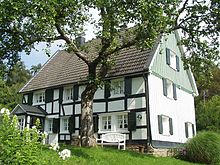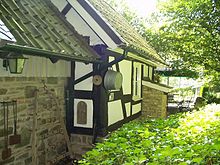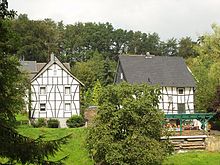Büschhof
|
Büschhof
municipality Nümbrecht
Coordinates: 50 ° 53 ′ 43 " N , 7 ° 34 ′ 35" E
|
|
|---|---|
| Height : | 300 m above sea level NN |
| Residents : | 39 (December 31, 2006) |
| Postal code : | 51588 |
| Area code : | 02293 |
|
Location of Büschhof in Nümbrecht
|
|
Büschhof is a district of Nümbrecht in the Oberbergischer Kreis in southern North Rhine-Westphalia within the administrative district of Cologne .
Location and description
The place is between the Nümbrecht districts of Malzhagen in the north and Wirtenbach in the south. To the west of the location there is a quarry in which Grauwacke is mined. The place is about 2.5 km east of the center of Nümbrecht as the crow flies.
history
First mention
Anyone who does just a little research into home and family history soon realizes that Büschhof cannot be thought without Löttgen. It looks as if the settlement here in the "bushes" (that was the oldest verifiable place name) goes back to the bearers of this name. Büschhof is first mentioned in 1698 in connection with the Homburg school regulations of Count Karl Friedrich from 1698, where the affiliation of Büschhof to the Drülshöhler ( Drinsahler ) school district is determined.
In contrast, the family name (with modifications) appears around 200 years earlier. The linguistic research on the development and meaning of the name should be left aside at this point. Only four spellings found are recorded here: 1500–1612 Lutgen, 1761 Lutgen, 1763 Lüttgen, 1795 Löttgen. Here is a facsimile from the fodder oat list of the parish Nümbrecht from 1559, signed by Aloffgen Lutgen from Oberbreidenbach . According to a complaint from the parish of Nümbrecht from 1592, Aloffgen Lutgen zu Oberbreidenbach was a church elder, so certainly a respectable court owner. If Aloffgen Lutgen is mentioned in the oat list in 1559, he must at least have had a father who has carried his name since around 1500.
In the 17th and 18th centuries, according to today's terms, time stood still. Around 1870, Homburg villages were still reminiscent of mediaeval conditions, houses and barns, fences and hedges, bushes and ridges, paths and footbridges, ponds and wells, but also farm work, tools and customs still had their ancient character.












